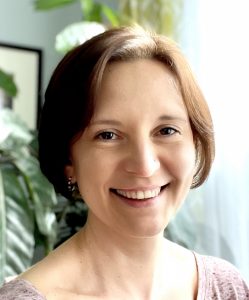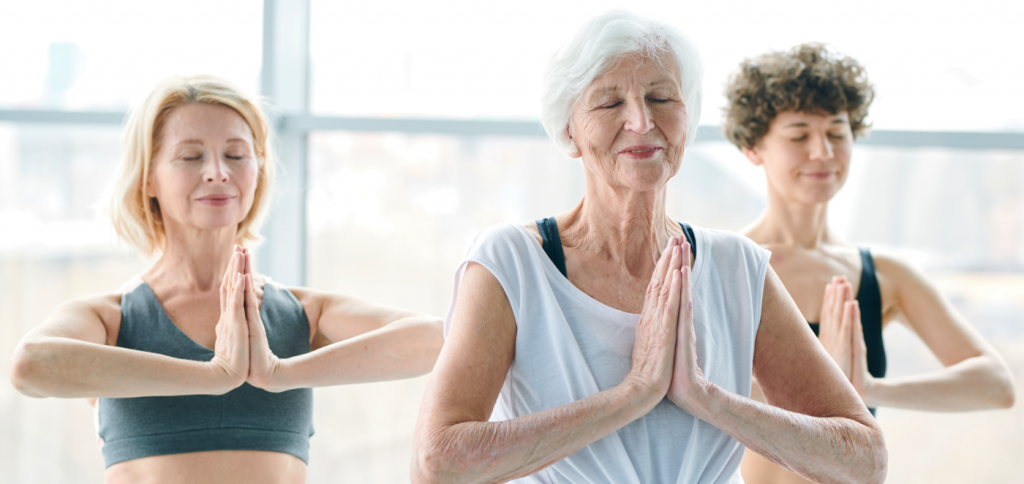
03 Apr What to include in a yoga program for students with osteoporosis
Some months ago, I met with a new student who’s been recently diagnosed with osteoporosis. She had scheduled a private yoga session to discuss her course of action. From our first conversation, it became evident how startled my student was by the diagnosis. She explained that she was doing everything right: eating right, exercising regularly, taking proper supplements, and so on, yet it didn’t prevent osteoporosis. Overnight my student’s perception of her body had shifted dramatically. Her body that seemed strong, reliable, and resilient just a few days ago, now felt frail, vulnerable, and weak. I find that this often happens with folks who are diagnosed with osteoporosis and many other diseases that seem to come out of nowhere for no apparent reason. Suddenly it feels as if the same body that was humming along cheerfully before the diagnosis had betrayed us and can no longer be trusted. This sudden change in how we experience the body and our perception of what it can and cannot do has to be addressed in our work with students and is just as important as the poses and practices we choose for them.
Last week we discussed the precautions we need to take when we have a student with osteoporosis in a yoga class. Today let’s dive a bit deeper and explore specific aspects of yoga practice we can focus on to help a group of students with osteoporosis diagnosis manage their condition. When you work with a small group of students who have been diagnosed with osteopenia or osteoporosis, there is some specific information you need to know about each student. Here are some sample questions you can ask them:
- How long have you had this diagnosis and what kind of progression did you experience
- Have you had bone fractures at any point in life?
- What have you been advised to do and not do movement-wise by your doctor?
- What kind of medication are you currently taking for it?
When osteoporosis progresses, it brings about some obvious challenges in the muscular-skeletal structure, like muscle wasting, loss of muscle tone, stooped posture, a general sense of rigidity in the body, restricted range of motion, and a potential sense of frailty. We can observe the degree of those changes and take them into consideration. When we design a program for students with osteoporosis, there are several specific areas we want to focus on.
Start with the breath. When we deal with the muscular-skeletal system, it is tempting to jump straight into movement. Yoga asanas certainly play an important role. However, starting with breath has a lot of advantages. It is safer. It can give you valuable information about the restrictions the student has in the movement of their ribcage. It will give you a sense of the general rigidity within their body. It helps your student tune in within, connect to their body and get a sense of control over their inner processes. Breath also helps us calm the mind (langhana practices) and increase the sense of vitality (brhmana practices), both of which are essential for students with osteoporosis and are discussed below. Begin with breath exploration to establish a starting point and gradually work on increasing breath threshold (depth and length of breathing).
Calm the mind. Using langhana breathing practices and gentle movement helps to regulate vata, decrease systemic inflammation, reduce perceived stress levels, and decrease sympathetic activation. All these factors are essential for bone health. Calming the mind also helps with reframing students’ perceptions of their bodies.
Increase the sense of vigor and vitality. When the body is perceived as frail and vulnerable, it is easy to get scared and anxious about the most mundane activities. Using brhmana breathing practices and simple yoga poses that make the student feel strong and accomplished can both strengthen the body and counteract the anxious internal narrative. The key is to choose poses that the student can do comfortably without much accommodation.
Work on posture. A stooped posture with a concave chest is common with osteoporosis. Our goal in working with posture is to prevent chest collapse and ribcage rigidity. We do it from the outside by increasing upper back strength and using gentle chest-opening poses and from the inside by increasing breathing capacity. Upper back rounding and forward head displacement often go together, so we also need to include movements that mobilize the neck and axial extension poses that help lengthen the spine and reposition the head.
Build muscular strength. Muscle wasting is a common feature of osteoporosis, which also contributes to the weakening of bones. Bones get stronger in response to muscular pull in all directions. When muscles are stronger and more toned, they pull harder on bones, causing them to become stronger, too. Gravity and resistance are the two main factors that help strengthen both muscles and bones; that is why weight-bearing activities have long been recommended for osteoporosis. We can create resistance by using small weights or resistance bands and by doing isometric movements where we press our knees or legs against our hands. Isometric movements are very effective for increasing muscular strength and improving overall stability in the body. Here are some examples of turning common yoga poses into isometric movements.
Increase range of motion. Stiffening around joints is common in osteoporosis and can lead to a progressive decrease in range of motion. This is one of those situations when you lose it if you don’t use it. To avoid those losses, we need to gently move the spine in all five possible directions of movement and regularly take the joints through the maximum safe range of motion. Keeping the joints supple also helps students function better in their daily lives.
Maintain and improve daily function. We need to support our students in their ability to do routine daily tasks without fear of falling or injury. Students need to be able to pick stuff off the floor, put on their shoes, transition down to the ground and be able to get back up, reach for higher shelves, and so on. We can include movements and yoga poses that mimic those routine activities and train our students to be more comfortable with them.
Improve balance. Working on balance is essential to prevent falls. We need to approach balance from the perspective of structural integration (to ensure that different body parts stack properly on top of each other and work well together), mental focus (to train the student to pay attention to their surroundings), and balance recovery (to teach the student to reclaim balance if they trip). Isometric poses work great for structural integration, simple balance poses and mental training techniques are excellent for mental focus, and dynamic balance poses are great for balance recovery.
The most crucial factor is consistently communicating to our students in words and actions that they are not their condition, not their diagnosis. It’s not who they are; it’s just something they have and can learn to live with, manage, and, potentially, improve. Continuously empowering our students by showing them that they can affect their current state with their actions and choices ultimately helps students trust their bodies again and resume living a rich and fulfilling life.
More articles on this topic
What we need to know about a student with osteoporosis when we work with them one-on-one
When a new student starts private yoga sessions, we usually ask many different questions about their current state: the functioning of various physiological systems, stress levels, sleep patterns, lifestyle, mental state, etc. Sometimes clients seem puzzled. They wonder – how is this relevant? “If I was diagnosed with osteoporosis and came here expecting to do weight-bearing exercises, why are you asking me about the regularity of my digestion? I thought we were just going to do some poses?”
How to accommodate a yoga student with osteoporosis in a general yoga class
Osteoporosis is a chronic disease that is characterized by porous, weakened bones. It usually presents as low bone mass (decrease in bone quantity) and deterioration of the microarchitecture of bones (decrease in bone quality). Since the quantity and quality of bone are reduced, the risk of fracture is increased. Most of these fractures occur in the spine (vertebrae), forearms (radius), or hip (femur). The fractures can happen following the most mundane tasks like picking something off the floor. Falling is particularly problematic for folks with osteoporosis because of fracture risk. Fractures can lead to chronic pain, limited mobility, and even disfigurement, like the forward stooped posture, which, in turn, can affect heart and lung capacity. Osteopenia is a condition that is characterized by loss of bone density and is very common with aging. Osteopenia is a risk factor for developing osteoporosis, but it doesn’t necessarily lead to it. Osteopenia often serves as a first wake-up call to address bone density.
About Olga

Educated as a school teacher, Olga Kabel has been teaching yoga for over 15 years. She completed multiple Yoga Teacher Training Programs, but discovered the strongest connection to the Krishnamacharya/ T.K.V. Desikachar lineage. She had studied with Gary Kraftsow and American Viniyoga Institute (2004-2006) and received her Viniyoga Teacher diploma in July 2006. She continued her studies with AVI and become an AVI-certified Yoga Therapist in April 2011.
Olga is a founder and managing director of Sequence Wiz – a web-based electronic health records system andyoga sequence builder that assists yoga teachers and yoga therapists in creating and organizing yoga practices. It also features simple, informational articles on how to sequence yoga practices for maximum effectiveness. Olga strongly believes in the healing power of this ancient discipline on every level: physical, psychological, and spiritual. She strives to make yoga practices accessible to students of any age, physical ability and medical history, and specializes in helping her students relieve muscle aches and pains, manage stress and anxiety, and develop mental focus.



